Contents
- What does the stool coprogram show?
- Indications for scatological examination
- How to donate feces: preparation and collection rules
- Answers to frequently asked questions about coprogram
- The norm of the coprogram of feces in the table
- Deciphering the coprogram in children and adults
Coprogram – this is the result of a diagnostic study, known under several names: coprology, coproscopy, general analysis of feces.
The essence of the procedure is to study the physical, chemical and microscopic properties of human feces in order to determine possible pathologies of the gastrointestinal tract. Until the moment when the food bolus (chyme) gives up its beneficial components and is converted into feces, it sequentially passes through all the organs of the digestive system and undergoes processing. That is why the state and composition of feces can be used to judge a lot of disorders, ranging from inflammatory processes and parasitic invasions to oncological diseases of the stomach, liver, intestines, and pancreas.
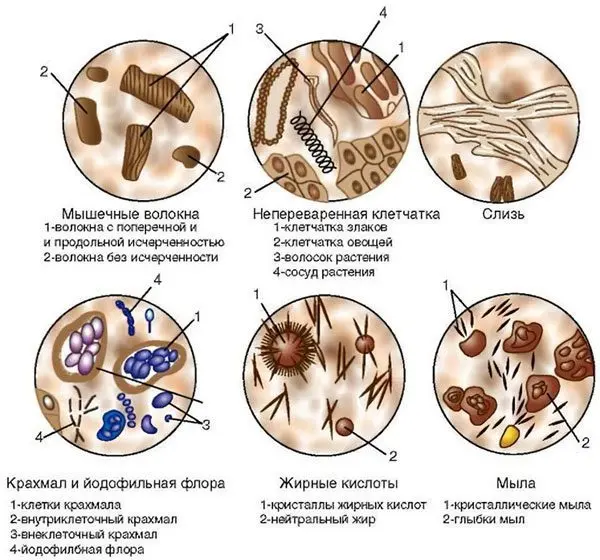
When you have a ready-made coprogram in your hands, decoding can cause difficulties, because opposite the indicators in the form there will be letter abbreviations, numbers, or even just pros and cons, but it’s not clear what they mean. Of course, the doctor will answer your questions, but almost any person is interested in understanding the results of the examination himself. We will help you with this and tell you in an accessible language about how to pass a coprogram correctly, what this diagnostic procedure shows, who needs it, what are the norms for a general fecal analysis in children and adults, and what deviations from healthy indicators may indicate. But we want to emphasize that the information provided does not replace medical advice, especially in the presence of a serious ailment.
What does the stool coprogram show?
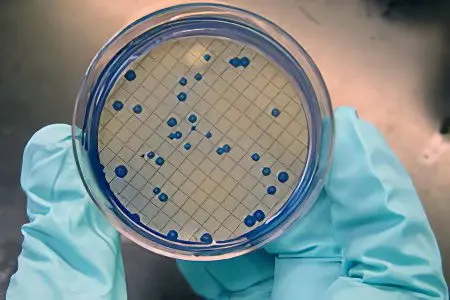
As part of a scatological study, the following types of stool properties are assessed in stages:
macroscopic – daily volume, shape of feces, their consistency, color and smell, the presence of impurities (remnants of undigested food, mucus, blood, pus, parasites and their cysts);
chemical – acid-base reaction of stools, the presence of occult blood, bile pigments and soluble proteins in them;
microscopic – the presence of detritus, starch, fatty acids, connective tissue, leukocytes, erythrocytes, fungi and other components.
Based on these parameters, the doctor can assess the functional status of the patient’s gastrointestinal tract – how well the food is digested, whether it moves correctly, whether nutrients are absorbed in the right amount. In addition, the fecal coprogram allows you to suspect an inflammatory or oncological process in the digestive system, disorders of the pancreas, liver, stomach and intestines, the presence of gallstones, diverticula, hemorrhoids, varicose veins of the esophagus and many other pathologies.
Indications for scatological examination

Seeing a doctor for a referral for a stool test is essential if you have any of the following symptoms:
Abdominal pain – girdle, in the epigastrium, upper or lower abdomen, in the right or left hypochondrium. The nature and cyclical nature of the pain does not matter – even mild discomfort in the liver, stomach, intestines or pancreas should prompt you to be examined, especially if they have no obvious cause and often recur;
Belching, heartburn, nausea, vomiting, pathological taste in the mouth;
Bloating, flatulence, diarrhea, constipation;
Strange appearance, smell, color of stools, their abnormal volume, the presence of suspicious inclusions;
Spots of blood, pus, or mucus on underwear adjacent to the anus, as well as soreness, itching, or foreign body sensation in the rectum;
The need to monitor the condition of the gastrointestinal tract against the background of ongoing treatment, before diagnostic manipulation, surgery or for prophylactic purposes (preferably annually);
Suspicion of poisoning, neoplasm, parasitic invasion;
Allergy, intolerance to certain foods;
Sudden, significant weight loss for no apparent reason;
The coprogram of the baby is performed if there is frequent and severe belching, colic, diarrhea, constipation, difficulties with the introduction of new complementary foods.
How to donate feces: preparation and collection rules
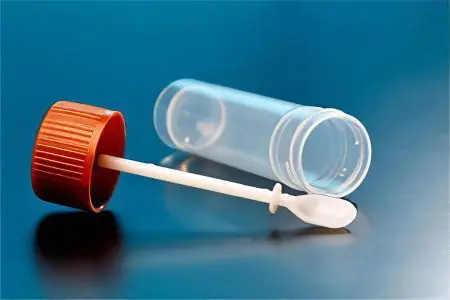
It is very important to carefully consider the doctor’s recommendations regarding preparation for the study, the accuracy of decoding the results of the coprogram depends on this, and hence the correct diagnosis.
So, let’s consider how to pass feces for analysis correctly:
Even at the stage of obtaining a referral, it is necessary to tell the doctor about all the medicines that you have used in recent weeks or are currently taking, as well as about all diagnostic procedures completed the day before. The fact is that radiopaque agents affect the composition of stools, and invasive manipulations, such as colonoscopy, can lead to internal damage and bleeding from the intestines. Unwanted drugs include antibiotics, anthelmintics and laxatives, activated charcoal, iron and bismuth preparations, rectal suppositories and many other medicines, so it is better to warn the doctor about all of them in advance;
3-5 days before the scatological examination, it is necessary to adjust your diet – remove from it dishes and foods that color feces in uncharacteristic colors (beets, red and black berries, carrots, spinach). It is possible that the doctor will ask you to go on a special diet, which will clarify the existing violations of the work of certain digestive organs. For example, your doctor may recommend that you eat mostly grains, dairy products, raw vegetables and fruits, protein foods, and so on for several days;
Immediately before collecting feces for a coprogram, you need to urinate, because otherwise, during a bowel movement, urine is likely to be released from the bladder and enter the sample for research, and this should not be allowed. Then it is necessary to make an intimate toilet – thoroughly wash the perineum with soap, paying special attention to the perianal zone, rinse and wipe dry;
Collecting feces for analysis directly from the toilet is not recommended – there will be either pathogenic bacteria in large quantities, or traces of aggressive detergents. It is better to prepare a convenient container (an old pot, a bowl), wash it thoroughly, pour boiling water over it and defecate there. The coprogram in children is taken from a clean pot, in infants – from a diaper or oilcloth, you should not collect a sample from a diaper, since the filler may contain chemical impurities that distort the decoding of the research results;
Defecation should occur spontaneously and naturally – you can not stimulate the intestines with drugs or give an enema. The stools obtained in this way are unsuitable for analysis. When the process is complete, immediately collect samples from different parts of the feces, especially from those areas that differ in color and consistency or have suspicious inclusions. The best way to collect feces is a special plastic container with a spoon, which can be purchased at a pharmacy. To conduct a scatological study, approximately 20 g of material is needed;
The stool sample must be delivered to the laboratory within a maximum of 2 hours after collection, with the lid of the container tightly closed immediately to prevent exposure of the stool to open air. Preliminary storage of the material in a refrigerator at a temperature not exceeding -5 ° C and not longer than 12 hours is allowed. However, the sooner you bring feces for research, the more objective the results will be.
Answers to frequently asked questions about coprogram

How much does a fecal analysis for a coprogram cost? The price depends on the region and the policy of private clinics; on average, a scatological examination in a good medical center will cost you 350-1000 rubles. In a state polyclinic, you can donate feces for free if there are relevant complaints and after presenting a compulsory health insurance policy;
How long to wait for the result? Medical institutions that provide services to the public on a commercial basis, as a rule, do this very quickly – they provide a transcript of the coprogram the very next day. Laboratories at polyclinics in 1-3 days transfer the finished analysis form directly to the doctor to whom the patient applied – usually a local therapist or pediatrician. Therefore, you can find out the results of the study as soon as you come to the next appointment;
Is it possible to freeze and hand over yesterday’s feces for analysis? Yes, this is perfectly acceptable. Everyone has their own biorhythms – there are people who habitually empty their intestines in the evenings, and in the morning they don’t feel like going to the toilet at all. With young children, especially with babies, the coprogram sometimes becomes an impossible task if you try to collect the morning, fresh feces without fail and immediately deliver it to the laboratory;
Is it necessary to donate feces in a special container? No, but it meets all hygiene requirements, is easy to use and inexpensive. Private clinics usually issue such containers along with a referral to a coprogram, their price is included in the total cost of the service. And in the state laboratory, they will take feces from you in any suitable container – a small sealed jar made of plastic or glass, but they will ask if you washed it well;
Сколько кала нужно сдавать на копрограмму? A volume approximately equal to one teaspoon is enough, but it is better to collect a sample from different parts of the stool, so that it becomes possible to objectively assess the composition and properties of the stool as objectively as possible. If you use a special container with a spoon, then scoop 3-5 servings from the top, side and middle of the feces;
Is it possible to do a coprogram during menstruation? Undesirable, it is better to wait until the end of menstrual bleeding in order to be sure that the blood does not get into the test sample and does not distort the decoding of the coprogram. If there are urgent indications, the state of health is threatening, then a fecal analysis can be taken, but during defecation it is necessary to securely close the entrance to the vagina with a hygienic swab or sterile cotton;
Is it true that you can’t have anal sex before a coprogram? Yes, this is true, and, due to the delicacy of this topic, not all doctors warn patients about the need to temporarily refrain from such pleasures. During anal sex, bleeding damage to the rectum may occur, and even if they are microscopic, deciphering the coprogram will give a false positive test result for occult blood;
Is it always enough what the coprogram shows to make a correct diagnosis? No, this is a basic test that allows you to suspect a problem and outline a further examination strategy. Very often, following the results of coprology, the patient is referred for bacteriological analysis of feces, ultrasound of the abdominal organs, radiopaque tomography, colonoscopy, sigmoidoscopy and other diagnostic procedures.
The norm of the coprogram of feces in the table
Deciphering the coprogram in children and adults

Now let’s briefly look at each of the indicators in the table and outline the possible causes of deviations from the norm. But first, we emphasize once again that this is the task of a qualified doctor, especially considering the fact that the results of a scatological examination alone, without taking into account symptoms, medical history and data from other tests, mean little and cannot serve as a basis for making a final diagnosis.
Daily volume
The daily volume of feces varies depending on the nature of the diet: it increases from the abundance of raw plant foods, and decreases from the predominance of protein foods (meat, fish, eggs), but in any case, the amount of feces excreted by a person per day should be within the norm indicated in the table.
An increase in the amount of feces – causes:
Enterocolitis;
Cholecystitis;
Pancreatitis
Fermentative or putrefactive dyspepsia;
Strengthening intestinal peristalsis;
Irritable Bowel Syndrome.
Decrease in the amount of feces – causes:
Malnutrition;
Constipation.
Consistency
The consistency of feces is influenced, first of all, by the content of water in them. Normally, the stool should be fully formed, cylindrical in children and adults – this happens if the bowel movements are 70-75% liquid. The exception is babies: if the mother is breastfeeding the baby, his feces will be mushy, and if the baby eats artificial milk formula, the feces take on the appearance of putty, and this is quite normal.
Abnormal stool consistency – causes:
Very hard (“sheep”) – constipation, stenosis of the large intestine or spasms of its walls;
Liquid – diarrhea, irritable bowel syndrome, increased peristalsis;
Foamy – fermentative dyspepsia, enterocolitis, dysentery, salmonellosis;
Ointment – pancreatitis, cholecystitis, cholelithiasis.
Color

The feces of a healthy adult and a child older than a year are brown, due to the presence of the bile pigment stercobilin.
Babies who are exclusively breastfed have light yellow, golden yellow, or greenish yellow stools. The stools of formula-fed babies are slightly different in color – they are dark yellow, dark orange or tan.
If we talk about the color of the feces of adults, then it is strongly influenced by the products included in the diet, as well as some medicines. Therefore, adequate decoding of the coprogram becomes difficult when the patient neglects the rules of preliminary preparation for the study.
Abnormal stool color – causes:
Black, tarry – bleeding from the upper gastrointestinal tract, varicose veins of the esophagus, ulcer or stomach cancer;
Dark brown – constipation, excess protein food or a violation of the process of its digestion, colitis, dyspepsia;
Light brown – excess plant food, irritable bowel syndrome, increased peristalsis;
Red-brown – ulcerative colitis;
Light yellow – pancreatitis;
Gray-white – hepatitis, cirrhosis of the liver, blockage of the biliary tract.
Smell
The characteristic smell of feces is due to the presence of methane, phenol, skatole, indole, hydrogen sulfide and other compounds in them. Their ratio, in turn, is affected by the composition of the diet. However, in any case, when deciphering the coprogram, an unsharp, familiar smell is considered the norm for children and adults. The feces of babies up to six months have a sour smell due to the fact that such small children eat either mother’s milk or an artificial mixture. In the second case, the smell will be sharper.
Abnormal smell of feces – causes:
Sour – fermentative dyspepsia;
Putrid – enterocolitis, disruption of the stomach, putrefactive dyspepsia;
Fetid – pancreatitis, cholecystitis, cholelithiasis, blockage of the biliary tract;
Rancid oil – hepatitis, fatty hepatosis, cirrhosis of the liver.
undigested food
In the faeces of a healthy person, particles of undigested food should normally be absent. If they are present, especially in large numbers, this is an alarm signal that indicates a serious disruption of the stomach, pancreas or liver.
Slime
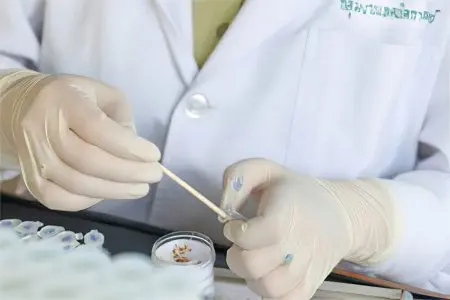
In infants, a small amount of mucus may be present in the feces, but it should be transparent and barely noticeable. For older children and adults, the presence of mucus in the stool is a deviation from the norm and a sign of trouble.
Mucus in the stool – causes:
Hemorrhoids;
Polyposis or diverticulosis intestines;
cystic fibrosis;
Celiac disease;
Malabsorption syndrome;
lactase deficiency;
Acute intestinal infection;
parasitic invasion;
Irritable Bowel Syndrome.
Blood
Neither in adults nor in children, when deciphering the coprogram, should blood appear in the stool – this is an extremely undesirable sign indicating the presence of a serious pathology of the digestive tract. Depending on what kind of blood is, in what volume and when it is released, one can speculate about the causes of the problem.
Blood in the stool – causes:
Scarlet blood on toilet paper or on top of feces – hemorrhoids, anal fissure;
Blood streaks – ulcerative colitis, Crohn’s disease, colon cancer;
Blood in loose stools – dysentery and other intestinal infections;
Mucus with blood – paraproctitis, ulcerative colitis, polyposis, diverticulosis;
Blood stains on underwear – rectal cancer;
Abundant bleeding from the anus – ischemic colitis, damage to the hemorrhoid.
Pus
The presence of purulent inclusions in the feces of infants, older children or adults is a gross deviation from the norms of the coprogram and, most often, indicates the presence of an inflammatory process in the digestive tract. In this case, additional examination is necessary, aimed at establishing the cause and exact localization of inflammation, as well as a specific type of pathogens.
Parasites, cysts
In the feces of a healthy adult or child, there should be no protozoa, worms and their eggs. If, when deciphering the results of coprology, they are found, it is necessary to conduct specific antiparasitic therapy, which the doctor must prescribe. Remember that most antihelminthics are toxic, and you need to select the right medicine taking into account all the characteristics of the patient’s health status, especially if it is a small child.
Acidity, pH
Babies have a slightly acidic or acidic bowel reaction due to the fact that the basis of their diet is mother’s milk or artificial milk formula. Older children and adults have a neutral fecal reaction. An excess of carbohydrate food or its poor digestion can shift this indicator to the acid side, and protein to the alkaline side.
Violations of the acidity of feces – causes:
Alkaline (pH 8,0-8,5) – pancreatitis, colitis, constipation;
Slightly alkaline (pH 7,5-8,0) – disruption of the small intestine;
Strongly alkaline (pH above 8,5) – putrefactive dyspepsia;
Strongly acidic (pH below 5,5) – fermentative dyspepsia.
The stool test for occult blood should be negative. If this is not the case, then perhaps a person has erosive gastritis, a stomach ulcer, ulcerative colitis, diverticulosis, hemorrhoids, or even a malignant tumor of the gastrointestinal tract – the list of diagnoses can be very long and varied. Therefore, a positive result of the analysis of feces for occult blood when deciphering the coprogram becomes the reason for an in-depth examination of the patient.
Bilirubin
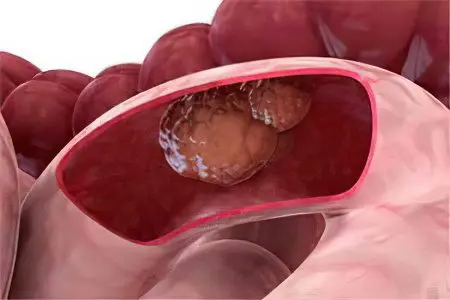
Normally, the intestinal microflora processes the bile pigment bilirubin and turns it into stercobilin. However, in babies up to 6 months, the body is only colonized by bacteria, and a healthy balance is formed between them. Therefore, the presence of a small amount of bilirubin in the feces in infants is a variant of the norm, while for adults this is already a serious deviation.
Bilirubin in feces – causes:
irritable bowel syndrome;
Enhanced peristalsis and accelerated evacuation of feces;
Intestinal dysbacteriosis as a result of long-term antibiotic therapy.
Stercobilin
This substance is the result of the processing of bilirubin by intestinal bacteria and causes the characteristic brown color of stools. For a day, a person releases from 75 to 350 mg of stercobilin. The coprogram of the baby may show lower values. But in an adult, this indicator should be within the established norm.
Stercobilin in feces is increased – causes:
Hypersecretion of bile;
Hemolytic anemia.
Stercobilin in feces is lowered – reasons:
Pancreatitis
Hepatitis;
PPE;
Cholangitis;
mechanical jaundice.
Soluble protein
When deciphering the coprogram, the indicator of the presence of soluble protein in the feces should be negative, both in infants and older children, and in adult patients. If the result is positive, this indicates putrefactive dyspepsia or an inflammatory process in the digestive tract (gastritis, enterocolitis, pancreatitis).
Detritus
The term “detritus” refers to the totality of the smallest particles of digested food, as well as intestinal epithelial cells, bacteria and their metabolic products, salts, toxins and other components that are normally subject to regular evacuation from the body. Doctors consider detritus to be something like a coefficient of digestive efficiency – the more this substance in the feces, the better.
Ammonia
In healthy infants, the decoding of the coprogram shows the absence of ammonia in the feces, and in older children and adults, this compound may be present in the feces at a minimum concentration (20-40 mmol / kg), and this is the norm. If there is a lot of ammonia in the feces, this indicates problems with the digestion of protein foods, the presence of putrefactive dyspepsia or colitis.
Starch
This complex carbohydrate in healthy people is completely broken down in the process of moving through the gastrointestinal tract. Therefore, starch in feces should be absent, both in children and adults. If the decoding of the coprogram says otherwise, then the person has pancreatitis, gastritis with low acidity, or fermentative dyspepsia.
Neutral Fats
Triglycerides are an important source of energy, so they should normally be completely processed and absent in the feces. In infants, the presence of a small amount of neutral fats in the feces is permissible, because the enzymatic activity of the gastrointestinal tract has not yet reached the required level, but this is only a matter of time. If triglycerides are found in the coprogram in an adult or a child older than 1 year, then this indicates a violation of the pancreas, liver, gallbladder or small intestine.
Fatty acid
These substances are the result of the processing of neutral fats, but can also be contained directly in food. One way or another, fatty acids in the body of a healthy person are completely processed, which means that they should not be present in feces. With a significant deviation from the norm, pancreatitis, as well as liver or biliary tract disease, can be suspected. In infants, fatty acids can be determined in small amounts in feces due to inadequate enzymatic activity of the pancreas.
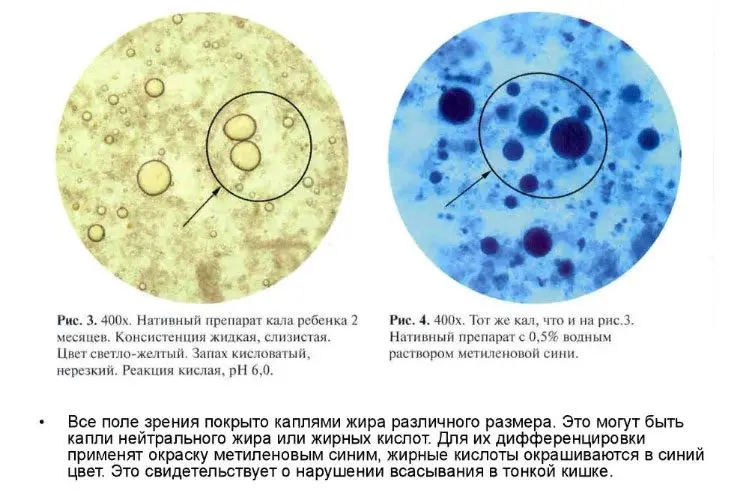
Soap
The result of the processing of fats in the gastrointestinal tract are soap compounds that are present in the feces of people of any age, including infants, and this is the norm of the coprogram. If the transcript of the results of the study indicates the absence of soaps in the stool, this indicates problems with the pancreas or liver, or the presence of stones in the gallbladder.
digestible plant fiber
Plant fibers are divided into two conditional categories: those that a person can digest, and those that cannot. These include hard fruit peel, nut husks, hard veins of plants. And all the fiber that the body is able to absorb should be absent in the feces. If it is present there, it means that the gastrointestinal tract cannot cope, or a person consumes too many raw vegetables and fruits.
Muscle and connective tissue fibers
Fragments of muscle fibers and connective tissues are one of the products of protein food processing – meat, fish, poultry, seafood. According to the norms for deciphering the coprogram, a small number of such inclusions can be found in the feces in children and adults, but the smaller they are, the better, because this indicates the good functioning of the enzymatic digestive organs.
leukocytes
These are immune cells, the presence of which in the stool indicates an inflammatory process in the gastrointestinal tract. However, the presence of single cells in the field of view during scatological examination is acceptable. An alarming signal is a significant content of leukocytes in feces. This situation requires further investigation.
Yeast fungi
Microorganisms of this type belong to opportunistic flora and are normally present in the intestines of healthy people of any age. However, if yeast fungi are found in feces, this means that their colonies have multiplied excessively, respectively, a person has dysbacteriosis. This often happens, for example, after taking antibiotics. Preparations containing live bifidobacteria and lactobacilli will help solve the problem.
Pathogenic flora
This category includes pathogens of dysentery, salmonellosis and other intestinal infections. Of course, normally, the decoding of the coprogram confirms the complete absence of these dangerous bacteria in the feces. If they are found, the patient needs antibiotic therapy, which will be prescribed by the attending physician.
Take care of yourself and be healthy!
Dietitian-nutritionist Uliana Lyubimova, CDC “Nutritionists of Russia” will tell you how to pass a coprogram correctly, decipher and self-diagnose digestion:









